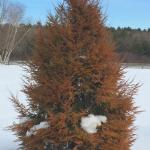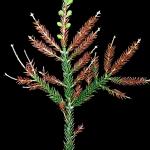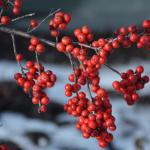A monthly e-newsletter from UMass Extension for landscapers, arborists, and other Green Industry professionals.
To read individual sections of the message, click on the section headings below to expand the content:
Hot Topics
Curious about Growing Degree Days and insect development?
Check out the new fact sheet by UMass Extension Entomologist Tawny Simisky: Using Growing Degree Days to Monitor and Time Treatments for Insect Pests in the Landscape. This fact sheet is a great resource for learning: What are Growing Degree Days?, What is a Developmental Threshold?, How Do I Calculate Growing Degree Days?, and How Do I use GDD’s in Management?
Growing Degree Days for Massachusetts are a part of the UMass Extension Landscape Message which returns in March!
Questions & Answers
Q.: Is there anything I can do now to prevent snow mold on my lawn this spring?
A.: There are two types of snow mold. Pink snow mold, AKA Microdochium or Fusarium patch (Microdochium niveum) is rarely a problem on residential lawns. Gray snow mold (Typhula incarnata) is more common. It affects all types of turfgrass, but Kentucky blue grass and fine fescues are somewhat less susceptible to damage than other species. Gray snow mold grows at 32-45ºF and typically requires >60 days of snow cover to develop. It is most likely to appear in areas with the greatest snow accumulation, so when removing snow from walkways, don’t shovel or snow-blow it onto the lawn. Do what you can to encourage rapid snow melt and drying of turf in spring. Consider pruning trees and shrubs to increase sun exposure in shady areas. Without the requisite snow cover, gray snow mold is not likely to be severe in the spring. When it does appear, it usually dries up and disappears in a short time.
If you have snow mold this spring, good cultural practices this summer will help prevent it from becoming a chronic issue. Gray snow mold seldom kills turf crowns. Rake up dead, matted leaves to encourage new growth. Light fertilization will help the grass recover. Manage thatch. Continue to mow until grass stops growing in the fall and remove clippings. Apply adequate but not excessive nitrogen in fall. Fungicides must be applied in late fall in order to be effective; however, snow mold on lawns can be usually be managed without fungicides if good cultural practices are employed.
Angela Maderias, Plant Pathologist, UMass Extension Plant Diagnostic Lab, UMass Amherst.
Trouble Maker of the Month
Winter injury to coniferous trees and shrubs in the landscape
Evergreen conifers in the landscape can suffer freeze injury during the winter months when they are exposed to subzero air temperatures along with strong winds. The record cold temperatures the northeast experienced over the Valentine’s Day weekend in 2016 is a good example of conditions capable of causing injury to landscape conifers. While most northern temperate conifers are adapted to withstand very cold temperatures, various stresses can affect cold hardiness. Conifers may become susceptible to freeze injury after drought, insect infestation or a disease outbreak disrupts their ability to properly acclimate to cold weather. Additionally, freeze injury can occur after a partial deacclimation of cold hardiness takes place due to above-average temperatures in late winter or early spring. Symptoms become visible in the spring when temperatures warm and appear as needle browning, premature needle shedding and stem/branch dieback. Conifers that are recently transplanted (especially eastern hemlock) and those planted in open settings exposed to harsh winds are more likely to suffer freeze injury during the dormant period. When freeze injury is identified, these killed plant parts should be pruned and removed to avoid colonization of the dead tissues by opportunistic insect pests and fungal pathogens.
Plant of the Month
llex verticillata, winterberry
The bright red berries that give llex verticillata its common name of winterberry, provide a vibrant pop of color in the winter landscape. The species grows 6-10’ tall and wide with an upright spreading form. Flowers occur in June, although flowers are not showy. Winterberry are dioecious, meaning that there are both male and female plants. One male plant is needed for every 6-10 female plants to ensure good fertilization and berry set. Berries color in October and persist fall through winter.
An eastern North American native, I. verticillata’s is often found along streams, woodland edges, or in swamps in its natural habitat. Winterberry is a good choice for wet areas or along ponds and streams, in shrub borders, native gardens, bird gardens, or as a hedge. Plants do well in full sun to part shade with an acidic soil. Fall color is not always good but can be purple-red. Winterberry does not have any serious insect or disease issues.
Cultivars of interest include:
- ‘Afterglow’ - a more compact (3-6’) female cultivar with orange red berries
- ‘Jim Dandy’ - a male cultivar that serves as a pollinator for certain female cultivars such as ‘Red Sprite’ and ‘Afterglow’
- ‘Nana’ (Red Sprite) - a dwarf (2-3’) female cultivar with large red berries
- ‘Winter Red’ – 6-8’ female cultivar with good fruit set or bright red berries
- ‘Winter Gold’ – 5-8’ female cultivar with good fruit set of orange-yellow berries. Needs a late-blooming male pollinator
Mandy Bayer, Extension Assistant Professor of Sustainable Landscape Horticulture, University of Massachusetts Amherst
Upcoming Events
Featured Event: 38th Annual UMass Community Tree Conference - Utilities, Communities and Urban Trees: Partnerships in Practice
The theme of this year’s conference will pertain to utilities and community trees. Topics will include: Design Solutions for Tree and Overhead Utility Conflicts, Utility Storm Resiliency, Communities and Utilities in Partnership for Urban Trees, and Updates from the UMass Diagnostic Lab.
Event Date/Time: Tuesday, March 7, 2017 - to 3:30pm
Event Location: Stockbridge Hall, UMass Amherst
Other Upcoming Events:
- 2/21: Principles and Fundamentals of Weed Science (A1)
- 3/2: Invasive Insect Certification Series, Part 3 of 3 - Management of Invasive Forest and Landscape Insect Pests
- 3/7: 38th Annual UMass Community Tree Conference - Utilities, Communities and Urban Trees: Partnerships in Practice
- 3/16: State Regulations Pertaining to INvasive Plant Management (A2)
- 3/21: The Invasive Plant Issue and Invasive Plant Identrification (A3)
- 3/30: Spring Kickoff for Landscapers: Sustainable Landscapes Management
For more information and registration for any of these events visit the UMass Extension Landscape, Nursery, and Urban Forestry Program Upcoming Events Page.
Additional Resources
For detailed reports on growing conditions and pest activity – Check out the Landscape Message
For commercial growers of greenhouse crops and flowers - Check out the New England Greenhouse Update website
For professional turf managers - Check out Turf Management Updates
For home gardeners and garden retailers - Check out home lawn and garden resources. UMass Extension also has a Twitter feed that provides timely, daily gardening tips, sunrise and sunset times to home gardeners, see https://twitter.com/UMassGardenClip
Diagnostic Services
A UMass Laboratory Diagnoses Landscape and Turf Problems - The UMass Extension Plant Diagnostic Lab is available to serve commercial landscape contractors, turf managers, arborists, nurseries and other green industry professionals. It provides woody plant and turf disease analysis, woody plant and turf insect identification, turfgrass identification, weed identification, and offers a report of pest management strategies that are research based, economically sound and environmentally appropriate for the situation. Accurate diagnosis for a turf or landscape problem can often eliminate or reduce the need for pesticide use. For sampling procedures, detailed submission instructions and a list of fees, see Plant Diagnostics Laboratory
Soil and Plant Nutrient Testing - The University of Massachusetts Soil and Plant Nutrient Testing Laboratory is located on the campus of The University of Massachusetts at Amherst. Testing services are available to all. The function of the Soil and Plant Nutrient Testing Laboratory is to provide test results and recommendations that lead to the wise and economical use of soils and soil amendments. For complete information, visit the UMass Soil and Plant Nutrient Testing Laboratory web site. Alternatively, call the lab at (413) 545-2311.







